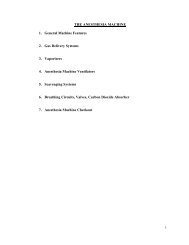BUMC Basics.pdf - Anesthesia Home
BUMC Basics.pdf - Anesthesia Home
BUMC Basics.pdf - Anesthesia Home
Create successful ePaper yourself
Turn your PDF publications into a flip-book with our unique Google optimized e-Paper software.
31<br />
Unstable Angina/NSTEMI<br />
• Can use history, physical exam, and TIMI risk score to<br />
stratify.<br />
• TIMI risk score will help dictate conservative versus invasive<br />
strategy.<br />
**Get Cardiology on case soon if not admitted by a<br />
cardiologist!<br />
Tests — Chest X ray, EKG, Echo (non emergent) and cardiac<br />
enzymes (Troponin and CKMB)<br />
EKG: Will show ST depression, T wave inversion, or<br />
nonspecific changes.<br />
Treatment — Revolves around three keys: (1) anti-ischemic<br />
therapy, (2) antiplatelet therapy, and (3) anticoagulation.<br />
• Anti-Ischemic Therapy: Nitrates, Beta blockers (don’t<br />
use if hypotensive, wheezing, bradycardia), Calcium<br />
channel blockers (nondihydropyridines, if can’t use beta<br />
blockers), morphine, and oxygen.<br />
• Antiplatelet Therapy: ASA, Plavix (load with 300 or<br />
600mg, don’t use if suspect going to CABG), GP IIB/IIIa<br />
inhibitors (pts with >3 TIMI risk score and positive cardiac<br />
enzymes)<br />
• Anticoagulation: UFH (bolus and wt. based titrate for<br />
aPTT of 50-70). Use bivalirudin if patient has heparin<br />
induced thrombocytopenia.<br />
Low Risk: Negative cardiac enzymes, no ST depression,<br />
TIMI score 3. Use GPIIb/IIIa and will need angiography<br />
with in 24-48 hours.<br />
STEMI<br />
• Immediately call cardiologist on call and activate cath lab.<br />
• Will have ST elevation in >2 leads with reciprocal changes or<br />
new onset of LBBB.




